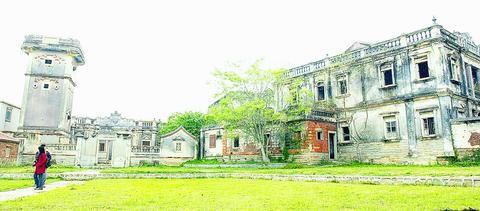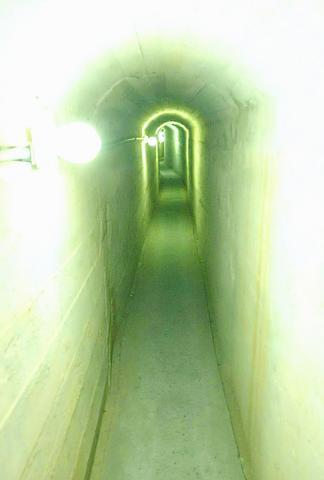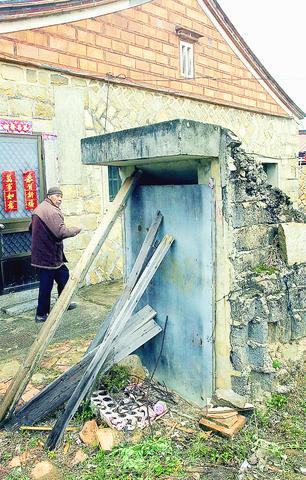Kinmen Island strikes most people as an armored military fortress situated in the frontline of the Taiwan Strait against China's military threat. Its military legacy is well known, but what lies underneath is a land rich in cultural diversity and architectural beauty.
Lying along the southeast coast of China's Fukien Province, Kinmen is of strategic importance for Taiwan's defense against China.
It first opened to tourism in 1994, which led to a rediscovery of Kinmen's unique mixture of Minnan culture and western influence. Kinmen is a major hometown of many overseas Chinese.

PHOTO: SEAN CHAO, TAIPEI TIMES
Singapore has the largest overseas Kinmen population. Today, the overseas Kinmen population outnumbers the locals.
Growing awareness of the island's vast Minnan heritage, western architecture and defunct military sites has prompted Kinmen locals and the central government to preserve and renovate the island's precious historical and cultural assets.
The Council for Cultural Affairs (CCA) has funds for a series of projects for these historical sites. The projects include cultural education programs and a Kinmen cultural park project. Subsidies available to Kinmen for cultural development totaled NT$428 million last year.

PHOTO: SEAN CHAO, TAIPEI TIMES
Under these initiatives, the renovation of western style buildings or Yang-lo (
Professor Chiang Bo-wei (
"They introduced western values, lifestyles and `novel' concepts of sanitation and hygiene to their hometowns. With funds channeled back to Kinmen from abroad, their families were usually better off than other locals," Chiang said.

PHOTO: SEAN CHAO, TAIPEI TIMES
The western style houses are hybrids of Chinese and western cultures, Chiang said.
Chiang who devoted his academic research to Kinmen's native Minnan Chinese and western style architecture, moved from Taiwan to Kinmen a decade ago.
"They [the structures] were built by successful Kinmen overseas businessmen upon their return from Southeast Asia," Chiang said.
The architectural style peaked in Kinmen between the 1920s and 1930s when there was a surge of funds coming into Kinmen.
The 131 western style buildings are located in some 50 villages and towns in the Greater Kinmen Island area and the Lieh-yu islet on the western side.
Shui-tou (
The western style architecture resembles colonial style buildings in Southeast Asia in both the Malay Peninsula and Singapore, Chiang said.
The "five-foot way" verandas, adopted from the British urban planning in Singapore during its colonization period in 1882, is a vivid representation of foreign cultural influence.
The "five-foot-way" refers to a clear passage measuring five feet wide in front of the store along with an attached overhanging roof to keep out rain and bright sunshine.
In Kinmen's Mofan Street (
The western style can be seen in the one-story "barbarian houses," the two-story "five-foot-way" buildings and the houses with overhangs.
"Barbarian house" is a derogatory term referring to a traditional Chinese house with a western pediment, while the western houses with verandas in Kinmen can be characterized as "five-foot-way" buildings -- structures which have become a distinctive architectural feature in Kinmen.
Most of the western style houses were built with brick and stone. Many of the structures are decorated with colorful Victorian tiles which give many of Kinmens's structures a distinctive appearance.
One can imagine the beauty of these buildings during the island's era of wealth. However, as the owners of these western houses have settled overseas, many of the buildings have been abandoned.
"The structures need good repairs and restoration," said CCA Chairwoman Tchen Yu-chiou (
"The revitalization of cultural and historical heritage is part of the objective in the council's development scheme for the nation's creative industry," Tchen said.
By recognizing the cultural value of Kinmen, Tchen said the abundant cultural features are a potential tourism attraction for Kinmen in addition to its military attractions.
"But first of all, we need to restore the essence of these cultural and historical assets," Tchen said.
However, for Kinmen, it seems that the island's economic reliance on the "small three links," which also makes Kinmen an important transit stop across the Strait, matters far more to the people in Kinmen than cultural development.
Local cultural workers complain that "the Kinmen government put the priority of the island's development on the opening of the `small three links.'"
"Many of our cultural works have been left in a state of disrepair," a Kinmen's cultural worker said on condition of anonymity.
In addition to the western style houses built by overseas Kinmen people, traditional Minnan Chinese houses -- spread around the villages of Kinmen -- also reflect a sense of antiquity about Kinmen.
Unlike Taiwan, where most traditional houses have been torn down and replaced by modern concrete structures, the Minnan architectural features from the Fukien Province in Kinmen have been well preserved.
Some of the Minnan buildings have roofs that have sharp, pointed shapes, while others display more circular curves. Yet all of the roofs all are designed according to Chinese geomancy on the concept of the five elements: gold, wood, water, fire and earth.
In Kinmen, villages are usually formed by people who have the same ancestral relations. Almost every village has an ancestral shrine bearing the symbol of the village, which is the family name of most of the residents.
Some of these ancestral shrines were built 450 years ago.
Due to a big exodus of Kinmen immigrants in other parts of Asia, and mainly in Taiwan, the old houses are kept up or lived in by the elderly.
Some people have built new antique-style houses to ensure that the buildings blend in with the older structures.
Many old ladies are not shy about inviting tourists in for a cup of tea and snacks.
Many of their descendents moved to live and work in Taiwan, and only during the Chinese New Year or major traditional festivals, do the children return home.
"This big house accommodates all of my children and grandchildren," an old lady said. "But their lives are better in Taiwan," she said.

US climber Alex Honnold is to attempt to scale Taipei 101 without a rope and harness in a live Netflix special on Jan. 24, the streaming platform announced on Wednesday. Accounting for the time difference, the two-hour broadcast of Honnold’s climb, called Skyscraper Live, is to air on Jan. 23 in the US, Netflix said in a statement. Honnold, 40, was the first person ever to free solo climb the 900m El Capitan rock formation in Yosemite National Park — a feat that was recorded and later made into the 2018 documentary film Free Solo. Netflix previewed Skyscraper Live in October, after videos

Starting on Jan. 1, YouBike riders must have insurance to use the service, and a six-month trial of NT$5 coupons under certain conditions would be implemented to balance bike shortages, a joint statement from transportation departments across Taipei, New Taipei City and Taoyuan announced yesterday. The rental bike system operator said that coupons would be offered to riders to rent bikes from full stations, for riders who take out an electric-assisted bike from a full station, and for riders who return a bike to an empty station. All riders with YouBike accounts are automatically eligible for the program, and each membership account

NUMBERS IMBALANCE: More than 4 million Taiwanese have visited China this year, while only about half a million Chinese have visited here Beijing has yet to respond to Taiwan’s requests for negotiation over matters related to the recovery of cross-strait tourism, the Tourism Administration said yesterday. Taiwan’s tourism authority issued the statement after Chinese-language daily the China Times reported yesterday that the government’s policy of banning group tours to China does not stop Taiwanese from visiting the country. As of October, more than 4.2 million had traveled to China this year, exceeding last year. Beijing estimated the number of Taiwanese tourists in China could reach 4.5 million this year. By contrast, only 500,000 Chinese tourists are expected in Taiwan, the report said. The report

Temperatures are forecast to drop steadily as a continental cold air mass moves across Taiwan, with some areas also likely to see heavy rainfall, the Central Weather Administration (CWA) said. From today through early tomorrow, a cold air mass would keep temperatures low across central and northern Taiwan, and the eastern half of Taiwan proper, with isolated brief showers forecast along Keelung’s north coast, Taipei and New Taipei City’s mountainous areas and eastern Taiwan, it said. Lows of 11°C to 15°C are forecast in central and northern Taiwan, Yilan County, and the outlying Kinmen and Lienchiang (Matsu) counties, and 14°C to 17°C